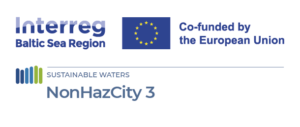What do we mean by “hazardous chemicals”?
Hundreds of man made chemicals are used in the products which we use every day and therefore we are exposed to a high number of different substances. Some of these chemicals are considered hazardous to human health and the environment. Hazardous substances are everywhere in our daily life. They mean to provide specific properties to different products (plastic elasticity, water resistance, antibacterial properties, etc.) but as a side effect they can harm nature and human health. Hazardous substances are present in different product groups where we never expect to find them. It can be personal care products, household cleaning products, toys for children, furniture and many other articles we use every day.
The problem
The term “hazardous chemicals” refers to substances which could cause harm to human health and the environment. Some chemicals may cause acute hazards to humans, e.g. be toxic (poisonous), cause allergies or irritate the skin. Others may have negative impact in the long run, e.g. may cause or promote the development of cancer, fertility problems, damage immune system.
Some substances are of especially high concern because they may damage humans AND the environment, they do not break down in the environment and therefore could occur in our food. Examples of such substances are some flame-retardants, polyfluorinated substances used to provide stain resistance or anti-stick properties or substances used as preservatives, such as parabens.
WHAT SUBSTANCES DO WE CALL “HAZARDOUS”?
Hazardous chemicals in products may enable such functions and properties as colour, dirt resistance etc., therefore they are sometimes needed for a product to work well. Some hazardous chemicals are allowed because their risk can be managed by wearing gloves or not ingesting large amounts of substances which are not supposed to be eaten.
However, there may be risks from so-called coctail effect, when combined exposures may occur from many different sources and consist of many different substances. They may cause negative effects, even though the exposure levels to the individual substances are regarded as safe.
Because of the stricter EU regulation of hazardous chemicals use in the products, manufacturers are shifting their production to non-EU countries. Even though similar regulations exist for imported goods, the controlling ability of our institutions is limited. This is why prohibited hazardous substances (e.g. lead in toys) or regulated substances in higher concentrations (e.g. formaldehyde in hair dyes) which can be identified only through laboratory analysis, may exist in imported products. For this reason it is useful to be aware what are the imported goods which most often prove to contain prohibited hazardous substances during routine inspections. By knowing this information you can avoid the use of these substances as much as possible in order to protect yourself and your children from chemical risks.
Chemicals of concern
- 1,2-dichlorobenzene
- 2-butanone oxime
- 2-ethoxyethyl acetate
- 2-methoxyethanol, 2-ethoxyethanol
- 3-benzylidene camphor
- 4-methylbenzylidene-camphor
- 4,4-Dihydoxybenzophenon
- Aniline
- Azocolourants
- Benzophenone
- Benzophenone-3 (oxybenzone)
- Biocides (diuron, 5-chloro-2-methyl-4-isothiazolin-3-one)
- Bisphenol A (BPA)
- Brominated flame retardants (deca-, octa-, penta-BDE)
- Chlorhexidine, Digluconate or Cetylpyridinium Chloride
- Chlorinated paraffinsCobalt bis (2-ethylhexanoate)
- EDTA (Disodium EDTA)
- Ethylene oxide, 1,4 Dioxane (by-product of SLS, myreth, oleth, laureth, ceteareth, PEG, polyethylene, polyethylene glycol, polyoxyethylene, oxynol)
- Ethylmethylketoxime
- Formaldehydes and formaldehyde releasers (e.g. benzylhemiformal, 2-bromo-2-nitropropane-1,3-diol, 5-bromo-5-nitro-1,3-dioxane, diazolidinyl urea, Imidazolidinyl urea, Quaternium-15, DMDM Hydantoin)
- Heavy metals (cadmium, chromium, lead)
- Isocyanates
- Mineral oils (Paraffinum liquidum, Wax)Nano particles (Nano titanium dioxide, nano zinc oxide, nano silver)
- Nitromusks, polycyclic musksNonylphenols (nonylphenol, p-nonylphenol, phenol, nonyl-, branched)
- Octamethylcyclotetrasiloxane
- Octyl methoxycinnamate (OMC, Ethylhexylmethoxycinnamate, Octinoxate)
- Octyl-Dimethyl- para-Aminobenzoic-Acid PABA (OD-PABA)
- Octylphenols (4-octylphenol, 4-tert-octylphenol)
- Organic solvents (Xylene, benzene (turpentine), n-hexane, hydro-treated heavy naphtha, ligroin, naphtha (petroleum), hydrodesulfurized heavy)
- Organotin compounds
- Parabens (propylparaben; butylparaben)
- Perfluorinated chemicals (PFC)
- Phenoxyethanol
- Phthalates (DEHP, BBP, DBP, DINP, DIDP, DIBP, DEP, DHP, DCHP, DNOP)
- PVC
- Sodium Lauryl Sulfate (SLS, Sodium dodecyl sulfate; Sulphuric acid, monododecyl ester, sodium salt; Sodium salt sulphuric acid; Monododecyl ester sodium salt sulphuric acid), Ammonium lauryl sulfate (ALS), Sodium Laureth Sulfate (SLES)
- Triclosan
- Zinc phosphate
Regulatory status
Some chemicals have already been proven to be hazardous for human health and the environment and their use is prohibited (across the European Union or worldwide), others are listed as possibly hazardous and their use is banned in some specific areas e.g. for use in children’s toys or cosmetics. In other cases some evidence exists about substances which could be hazardous, but substantial scientific evidence is still lacking.
WHAT IS THE LEGAL REGULATION OF HAZARDOUS CHEMICALS?
EU Legal Act
REACH is a regulation of the European Union, adopted to improve the protection of human health and the environment from the risks that can be posed by chemicals. It also promotes alternative methods for the hazard assessment of substances in order to reduce the number of tests on animals.
The CLP Regulation ensures that the hazards presented by chemicals are clearly communicated to workers and consumers in the European Union through classification and labelling of chemicals.
From 11 July 2013, this Regulation will replace the “Cosmetics Directive”
The Directive limits the amounts of certain chemicals that may be contained in materials used for toys
The Regulation improves protection of the environment from the harmful effects of substances found in detergents. It also requires complete labelling which includes any substance that could cause allergies.
This regulation aims to improve the functioning of the biocidal products market in the EU, while ensuring a high level of protection to humans and the environment.
The Directive limits the amount of certain hazardous substances used in paints for use on buildings, their trims and fittings and structures associated to buildings and products for vehicle refinishing.

